Successful projects run on shared understanding, but that clarity often breaks down when it comes to what the team is actually producing. Without a clear, agreed-upon definition of what needs to be created, teams risk scope creep, missed deadlines, and stakeholder disappointment.
This is where well-defined project deliverables become the foundation for execution. They transform abstract goals into tangible outputs that everyone can track, which is essential for the streamlined workflows we build on monday work management.
This blog post breaks down everything you need to know about deliverables. We’ll explore the different types, walk through a seven-step process for defining them, and provide practical examples from software, marketing, and design projects. We will also cover how to effectively manage and track them to keep your projects on course.
Try monday work managementWhat is a deliverable in project management?
A project deliverable is any tangible or intangible output produced as a result of project work that can be verified and measured. The deliverable definition in project management centers on specific items, results, or outcomes that must be completed and handed over to stakeholders during or at the end of a project.
To define ‘deliverable’ more clearly, think of deliverables as the concrete proof that work has been completed successfully. What is a deliverable in project management differs from goals or milestones because deliverables are actual outputs you can touch, see, or experience.
The meaning encompasses everything from physical products like printed brochures to intangible outputs like training sessions or software code. Understanding what deliverables are helps teams stay focused and aligned throughout the project lifecycle.
Different types of project deliverables
What are project deliverables exactly? Project deliverables fall into several categories that help teams organize their work and set clear expectations.
Understanding the various types helps answer what is deliverables in different project contexts. Each serves a specific purpose and requires a different management approach.
Internal deliverables
Internal deliverables are outputs used within the project team or organization to support project execution. These project management deliverables focus on planning, coordination, and progress tracking rather than final client-facing results.
The most common internal deliverables are:
- Project plans that outline tasks and timelines
- Status reports that track progress
- Meeting notes that document decisions
- Risk assessments that identify potential issues
These deliverables keep teams organized and informed throughout the project.
External deliverables
External deliverables represent what clients or customers receive as the project’s value. These final deliverables often require higher quality standards since they directly impact stakeholder satisfaction.
Examples of deliverables for external audiences are:
- Completed products
- Client reports
- User manuals
- Training materials
Process deliverables
Process deliverables support the project’s workflow and methodology. These deliverables of a project ensure consistent procedures and quality standards throughout execution.
Key process deliverables might include
- Workflow documentation
- Testing procedures
- Quality checklists
- Project schedules.
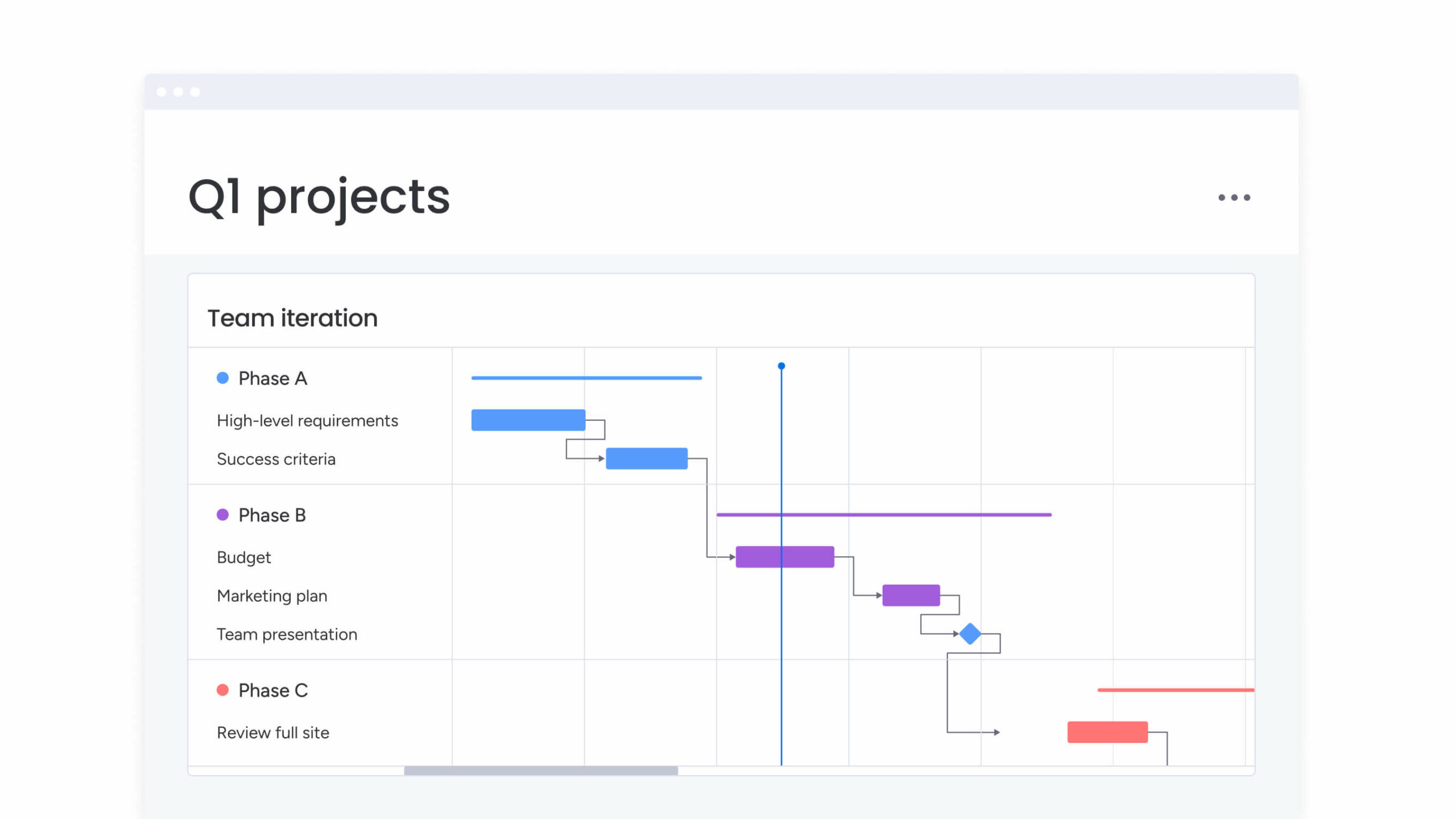
monday work management excels at managing all of these through automated workflows that maintain consistency across all project activities.
Try monday work management7 steps to define deliverables
How do you transform project objectives into concrete outputs? Following a systematic approach to define project deliverables prevents scope creep and ensures project success. These steps help teams create clear, actionable deliverables that align with stakeholder expectations.
The definition of project deliverables starts with understanding what the project must accomplish and translating those requirements into specific, measurable outputs.
Step 1: Map your project scope
Document the boundaries of your project, including what’s included and excluded from the work. Use scope statements to clarify these boundaries and connect each part of the scope to potential deliverables.
For example, a website redesign project might include updating the homepage and contact page, leading to deliverables like new page layouts and revised navigation. Clear scope mapping ensures teams create the right deliverables.
Step 2: Align with objectives
Ensure every deliverable supports a specific project objective. This step prevents teams from creating outputs that don’t contribute to the project’s ultimate goals.
If your objective is increasing user engagement, relevant deliverables might include an interactive tutorial or engagement analytics dashboard. monday work management’s goal-tracking features help maintain this alignment throughout the project.
Step 3: Use a work breakdown structure
A work breakdown structure divides the project into smaller, manageable parts. Create this structure to identify all necessary deliverables systematically.
The breakdown reveals dependencies between deliverables and helps teams sequence their work logically. This approach ensures comprehensive deliverable identification.
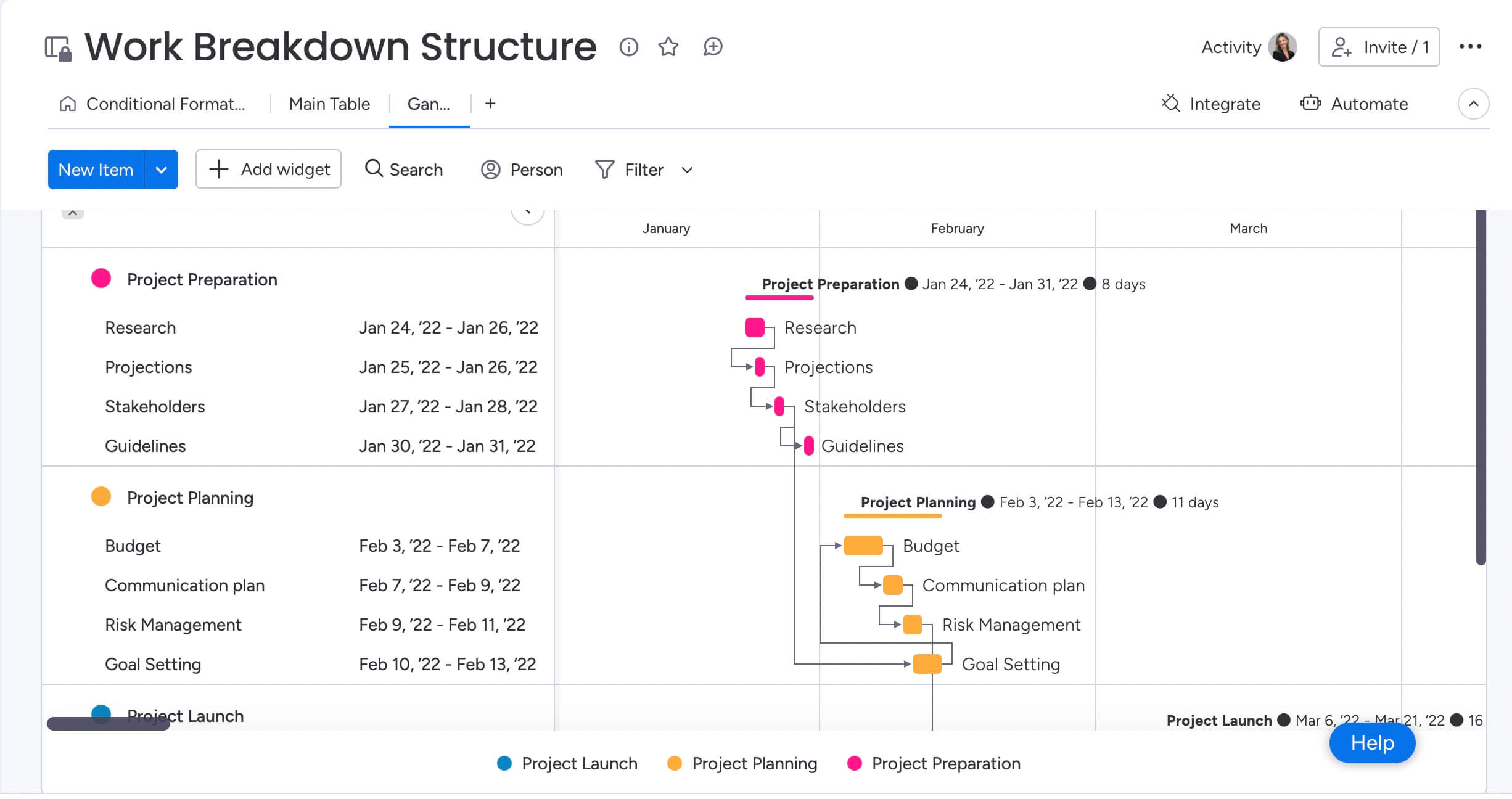
Step 4: Document acceptance criteria
Define what “done” looks like for each deliverable with specific, measurable standards. Examples include “brochure must be five pages and include pricing” or “website must load in under two seconds.”
Clear criteria help verify completion and prevent disputes about quality — and they boost motivation, too, with employees who understand how success is measured being 2× more likely to feel motivated, according to the World of Work report. These standards should be documented and agreed upon before work begins.
Step 5: Assign ownership
Assign a specific person or team to each deliverable using clear responsibility assignments. Effective ownership includes who will create, review, approve, and maintain each deliverable.
This clarity prevents confusion and ensures smooth handoffs between team members throughout the project lifecycle.
Step 6: Validate with stakeholders
Get stakeholder agreement on each deliverable and its acceptance criteria through structured validation sessions. Early validation prevents misunderstandings and reduces rework later.
Document these approvals to reference throughout the project and ensure everyone remains aligned on expectations.
Step 7: Track progress continuously
Monitor deliverable status throughout the project using dashboards and visual tracking. monday work management’s dashboards provide real-time visibility that keeps teams and stakeholders informed about progress.
Regular tracking enables proactive problem-solving and helps teams adjust when deliverables encounter challenges.
Try monday work management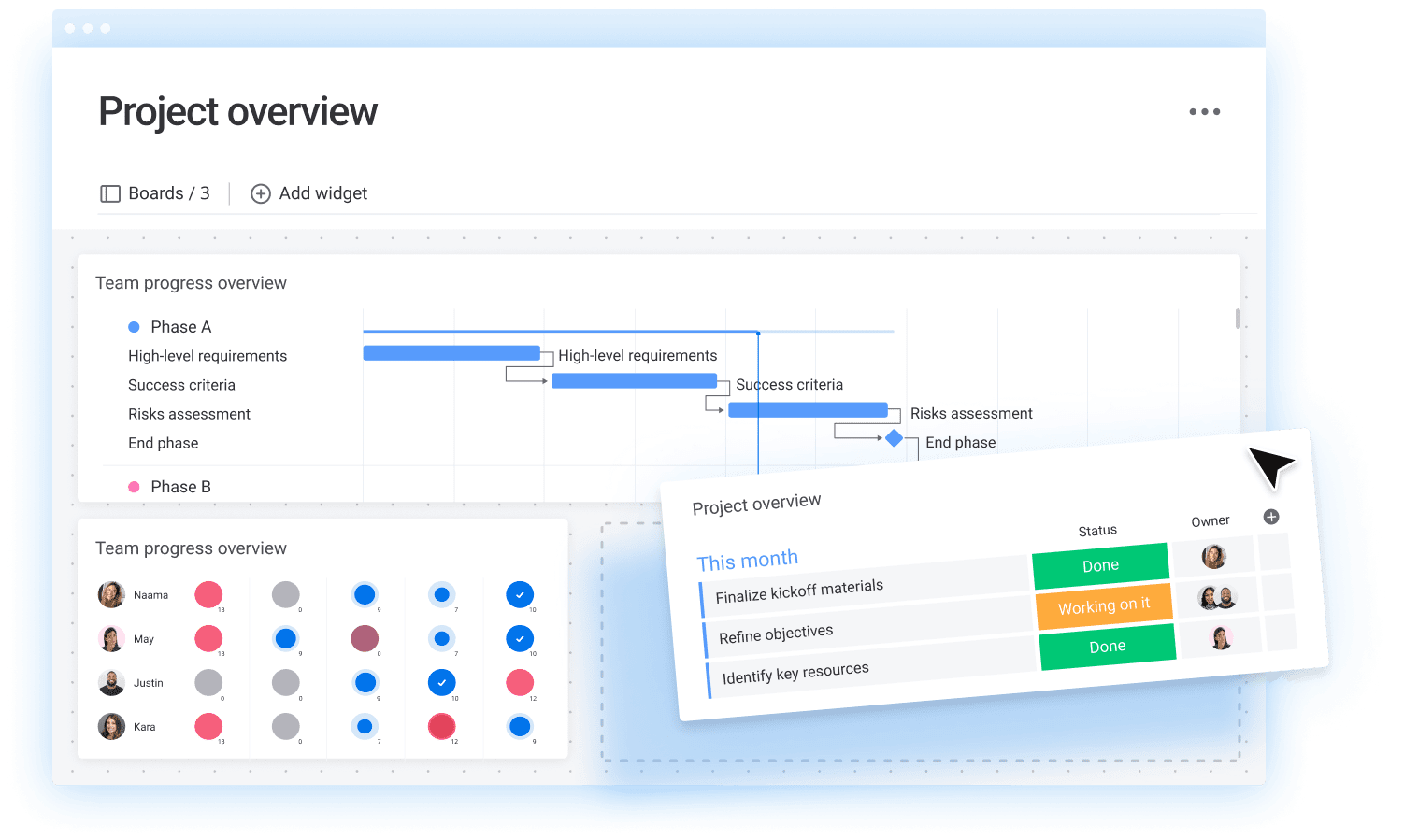
Examples of project deliverables
Seeing examples of real project deliverables helps clarify how teams translate objectives into concrete outputs across different industries.
They illustrate the wide range of outputs that projects can generate. Understanding examples of deliverables helps teams determine what their specific project outcomes should be.
Software development deliverables
Software projects produce both technical and user-facing outputs throughout the development lifecycle. These software development deliverables typically flow from initial requirements to final deployment.
Essential software project deliverables examples include requirements documents that specify functionality, functional prototypes that demonstrate key features, source code repositories with complete documentation, user guides for end-users, and final software releases ready for production.
Marketing deliverables
Marketing projects focus on creating materials that drive business objectives and customer engagement. Deliverables in marketing support campaign goals and provide measurable outputs for evaluation.
Key marketing deliverables include campaign strategy plans, creative assets like banners and videos, social media calendars with scheduled content, and performance analytics reports that measure effectiveness.
Design deliverables
Design projects progress from early concepts to polished, client-ready assets through iterative deliverables. Each design deliverable builds upon previous work while moving toward the final vision.
Essential design deliverables include wireframes showing basic layout, detailed mockups with visual elements, comprehensive style guides for consistent branding, and final design files ready for production.
Client deliverables examples
Client-facing deliverables vary by industry but always focus on demonstrating project value. These outputs represent the tangible benefits clients receive from their investment.
Typical client deliverables examples include project proposals outlining scope, progress reports maintaining transparency, final product delivery with agreed features, and support documentation for ongoing maintenance.
Pro tip: Organize deliverables by project phase to maintain momentum. Early deliverables validate concepts while final deliverables ensure successful handoff and long-term value.
How to manage and track your project deliverables
Successful management of your deliverables requires systematic tracking, clear communication, and proactive problem-solving. monday work management offers comprehensive features that make deliverable tracking transparent and efficient.
Teams need visibility into progress, dependencies, and potential issues to keep deliverables on track. Here’s what we recommend:
Set clear timelines
Establish realistic deadlines for each deliverable by considering dependencies and resource availability. Sequence deliverables logically to ensure prerequisite work completes before dependent activities begin.
Visual timeline platforms help map deliverable schedules and identify potential conflicts — a natural fit given that 82% of employees already rely on work/project management software to track tasks and collaborate. This approach creates shared understanding of project flow and critical milestones for all stakeholders.
Use automation features
Deliverable tracking and automation reduce manual work that can slow progress. Set up automated reminders for deadlines, status updates when deliverables complete, and approval workflows that route outputs to reviewers.
monday work management’s automation capabilities help teams stay on top of deliverables by triggering actions based on status changes, due dates, or project conditions. These processes ensure nothing falls through the cracks.
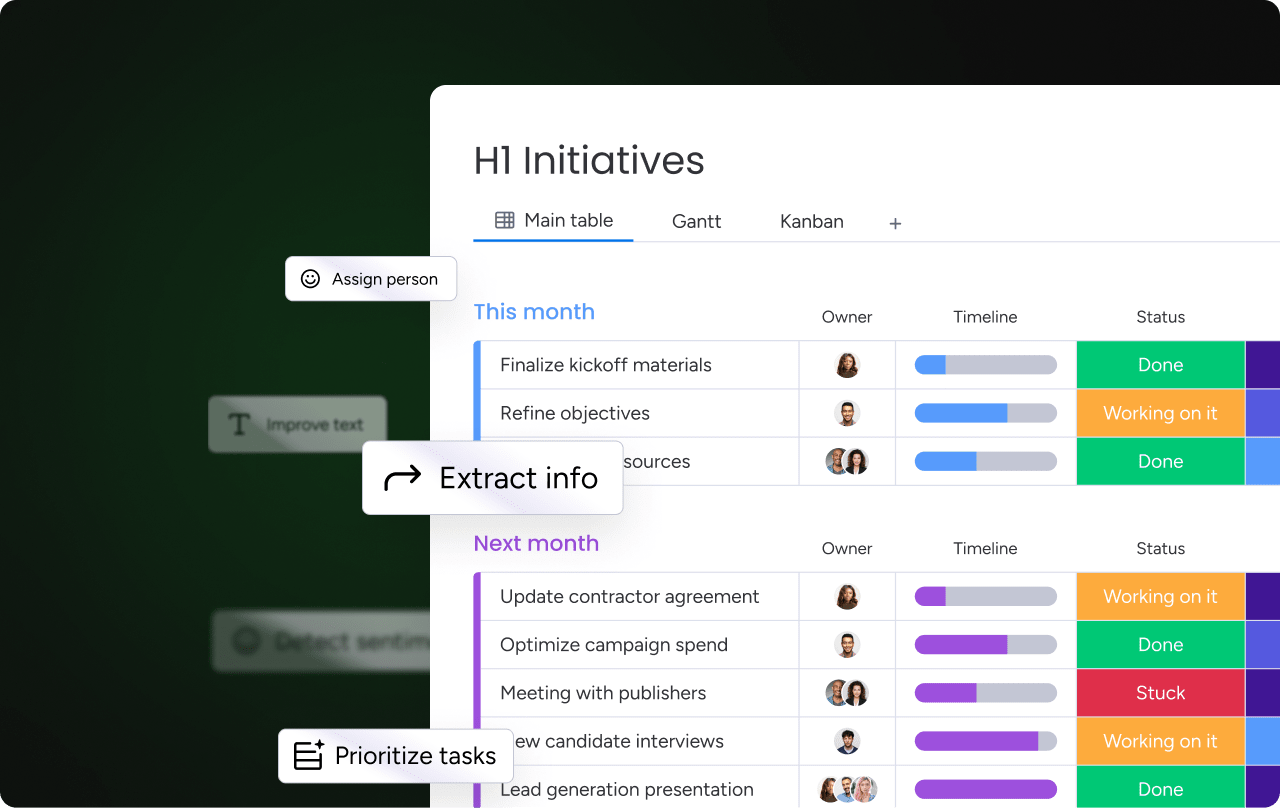
Communicate with stakeholders
Provide regular updates on deliverable status through dashboards, summaries, or structured meetings. Visual progress reports help stakeholders understand project status quickly without lengthy explanations.
Effective communication includes proactive updates when deliverables progress smoothly and immediate alerts when issues arise. This transparency builds trust and enables stakeholder support when needed.
Review and adjust regularly
Schedule regular reviews to assess deliverable progress through check-ins, retrospectives, or milestone meetings. Use these sessions to identify improvements and adjust plans based on feedback or changing requirements.
Regular reviews help teams catch issues early and make corrections before challenges become critical. This proactive approach keeps projects on track and ensures deliverables meet expectations.
Try monday work management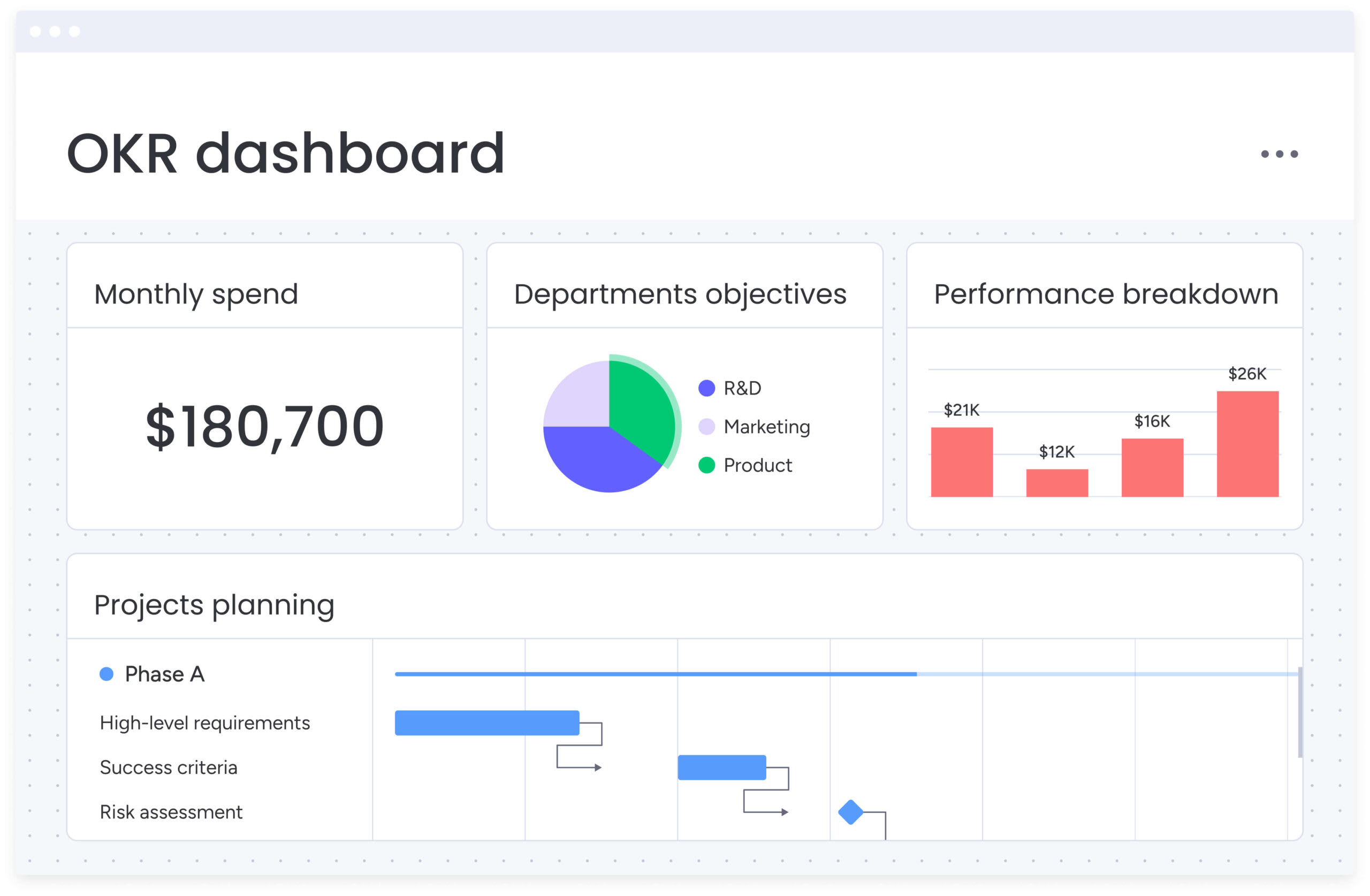
Turning deliverables into project success
Clear deliverables turn project uncertainty into focused action by giving teams specific goals and measurable results. When responsibilities are defined and progress is tracked, teams avoid scope creep and stay accountable.
In project management, deliverables are more than just outputs, they’re commitments and milestones that drive business value. A strong understanding of deliverables helps teams create reliable, repeatable results.
Curious how a structured approach can make deliverable tracking simpler? Explore how monday work management brings more organization and transparency to how teams deliver results.
FAQs about project deliverables
What is the difference between project deliverables and milestones?
Project deliverables are tangible or intangible outputs produced during a project, while milestones mark significant points in the project timeline without necessarily producing an output. Deliverables represent completed work that can be measured, whereas milestones indicate progress toward project completion.
How do you create acceptance criteria for project deliverables?
Effective acceptance criteria for project deliverables should be specific, measurable, and agreed upon by stakeholders before work begins. Focus on quality standards, performance requirements, and functional specifications that clearly define what constitutes a completed deliverable.
What makes a project deliverable successful?
A successful project deliverable meets all defined acceptance criteria, satisfies stakeholder expectations, aligns with project objectives, and is delivered within the agreed timeline and budget. Success also depends on clear communication and stakeholder validation throughout the creation process.
How do project deliverables vary across different industries?
Project deliverables vary across industries in their format, complexity, and regulatory requirements, though all follow the same principles of being measurable outputs that contribute to project objectives. Construction deliverables might include blueprints and completed structures, while software deliverables include code and user documentation.
What is the best approach to prioritize multiple project deliverables?
Prioritize multiple project deliverables by evaluating their impact on the critical path, dependencies with other deliverables, strategic importance to stakeholders, and resource requirements. Focus on deliverables that unlock subsequent work or provide the highest value to project success.
How should teams handle changes to project deliverables during execution?
Handle changes to project deliverables through a formal change management process that evaluates the impact on scope, timeline, and budget. Document all changes, get stakeholder approval, and update project plans to reflect new deliverable requirements while maintaining clear communication with all team members.
